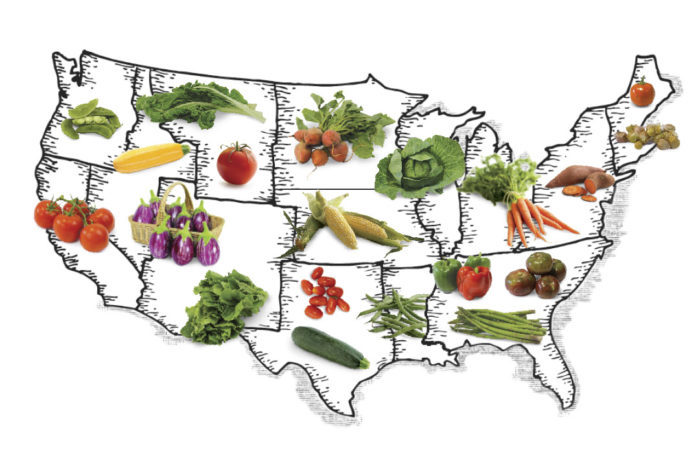
Are you really a bad vegetable gardener—or are you just growing the wrong veggies? According to experts that we’ve asked from across the country, many crop failures can be attributed to choosing the wrong variety of a given edible. Some varieties are specially bred for—or are just naturally better suited for—certain climates. In other words, it may not be your fault if you’ve failed with a specific crop in the past. It might be that you’ve just been planting the wrong type of melon, cucumber, or tomato. The following are veggies that will thrive in your specific conditions, so instead of crying at harvest time, you’ll be celebrating.
Northeast
Season length: Short
Top Pick: ‘Turkish Orange’ Eggplant is an attractive and delicious treat
Days to maturity: 65 to 85
Eggplants have got to be one of the most beautiful vegetables ever. There are so many shapes, sizes, and colors. ‘Turkish Orange’ is an heirloom variety that adds another color to the spectrum. This 3-inch round beauty is sweet, with little to none of the bitterness often associated with eggplants. As they mature, the fruit turns a darker orange, and the seeds mature—which impart bitterness to the flesh. The more mature fruits lend themselves to stuffing, allowing you to scoop out the slightly bitter seeds. The plants are diminutive, only growing 18 to 22 inches tall, but they yield a surprisingly large harvest. As with all eggplants, ‘Turkish Orange’ is a heat lover, so don’t put it out in your garden too early. Although I wouldn’t want to attempt to make eggplant parmesan or rollatini with these cute little guys, they can be used in most other eggplant recipes.

More Favorite Picks:
‘Mountain Fresh’ Tomato
Days to maturity: 77
‘Mountain Fresh’ tomatoes are well suited for growing in the Northeast, as they tolerate cool and wet conditions, and that seems like what we have every spring. It reliably produces big, flavorful red tomatoes weighing in at 8 to 12 ounces. This variety is resistant to several diseases (Fusarium wilt 1 and 2, nematodes, blossom-end rot, and Verticillium wilt). Check your soil pH, as it prefers soil ranging between 5.5 and 7.5. These determinate plants are great for home gardeners and market gardeners alike. They consistently rate high in our annual Tomato Basil Festival taste test, too.
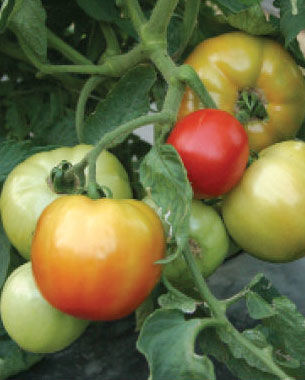
‘Aunt Molly’s’ Ground Cherry
Days to maturity: 65
‘Aunt Molly’s’ groundcherry is definitely not something that you’ll find at your local grocery store. This funny-looking fruit has acquired a following at our farm stand. Although they look like miniature tomatillo, this ½- to ¾-inch fruits are used more for snacking and baking. They are surprisingly sweet, tasting like a cross between a pineapple and a strawberry, with just the right amount of tang.
Their high pectin content makes them especially great for jam and pies. These plants are heavy feeders, so be sure to enrich your soil with plenty of compost. The seeds should be started indoors approximately four to six weeks before the last frost date. Ground cherries are tall, sprawling plants, so give them plenty of room in the garden.
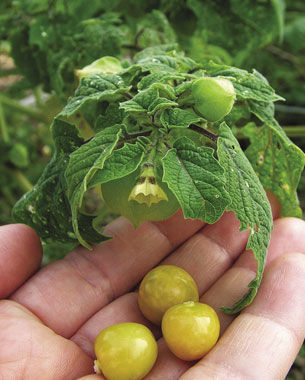
‘Savannah’ Bean
Days to maturity: 55
With this variety, you can expect to harvest loads of exceptionally dark green, straight, small-seeded, crisp green beans. ‘Savannah’ bean plants are sturdy, upright, and require no staking, which makes harvesting easy. This variety is resistant to several diseases including BCMV, NY15, curly top virus, golden mosaic, and anthracnose.
This is the perfect bean to snack on raw, fresh out of the garden. Flavorful when lightly steamed, they are delicious however you prefer to prepare them. Because of the straight bean pods, ‘Savannah’ beans are prized for canning and pickling. When you compare the look of this bean, side by side with any other, you will not be able to resist it.
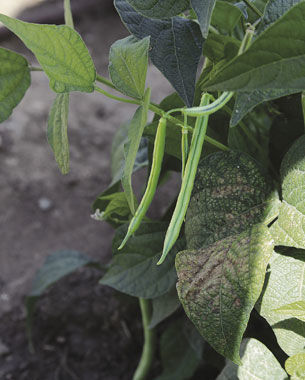
FG’s fun regional fact:
In 1975, Portland, Maine, saw its hottest August day ever, topping out at 103°F. Ten years earlier, the northeastern city saw its record coldest August day, dipping to 33°F.
Expert: Teri Smith and her husband, Joe, own Smith’s Acres, a 35-acre farm and nursery in Niantic, Connecticut.
Southeast
Season length: Long
Top Pick:
‘Carolina Wonder’ sweet bell pepper is a disease-resistant champ
Days to maturity: 75
‘Carolina Wonder’ is one of the best nematode-resistant sweet peppers. It is a consistent producer of large, classic bell-shaped, 3- to 4-inch-long peppers, which adorn compact, 2-foot-tall plants. The fruit is sweet when green but even more delicious when allowed to ripen fully to red. Harvest smaller, green fruits early in the season to keep the plants producing. Toward the end of summer, allow the peppers to mature to a bright red. Use clippers when harvesting to avoid breaking the fruit-laden branches. The large seed cavity of ripe ‘Carolina Wonder’ peppers is less prone to develop fungus than most varieties, making it great for stuffing.
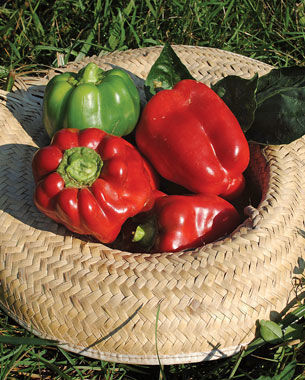
More Favorite Picks:
‘Golden Bush’ pattypan squash
Days to maturity: 68
Not all summer squash is shaped like zucchini. One of the tastiest options is a patty pan—also called “cymlings” by Thomas Jefferson, who remarked on their fine quality. The fruits look like little flying saucers and may take their name from a French scalloped cake pan. ‘Golden Bush’ matures two weeks later than some other summer squashes but has a superior flavor. It is a hardy, relatively compact plant that takes up less of your valuable garden space than vining varieties and is perfect for growing in large containers.
‘Golden Bush’ bears prolifically across a long season and is downy mildew resistant. The fruit is golden yellow, plump, and tasty. The flavor is best when small (2 to 3 inches in diameter), but some cooks find larger ones (4 to 5 inches) more convenient.
‘Cherokee Purple’ Tomato
Days to maturity: 85
‘Cherokee Purple’ tomato may well be one of the best-loved and most easily recognized heirloom varieties in the Southeast. Reportedly of Cherokee origin, this pre-1890 variety is somewhat exotic looking, ripening to a unique dark, dusky pink-purple color. Sometimes called a black tomato, ‘Cherokee Purple’ has a color that carries through to the flesh, especially at the stem end.
The flavor of the large 10- to 12-ounce fruit is rich, sweet, and complex with just a hint of acid. It’s always a favorite at tomato-tasting events. Back in 1993, Craig LeHouillier, author of Epic Tomatoes, introduced this popular variety to Southern Exposure Seed and to the rest of the seed world. The 5-foot-tall indeterminate plants are now a must-grow for many gardeners.
‘Pinkeye Purple Hull’ southern pea
Days to maturity: 65
In many areas of the South, ‘Pinkeye Purple Hull’ peas are a hometown favorite for their delicious flavor, early production, and disease resistance. The heavy set of purple pods is carried mostly above the foliage, making it easy to harvest. The twining, semi-bush plants benefit from some trellising. If the vines are kept well picked, they keep producing until frost kills them. The peas are equally good for canning, freezing, fresh eating, and drying. They’re perfect for cooking up a homegrown New Year’s good-luck meal, a Southern tradition.
FG’s fun regional fact:
Thomas Jefferson, perhaps the region’s most famous gardener, cultivated 330 different varieties of vegetables and 170 varieties of fruit at Monticello, his garden in Charlottesville, Virginia. In his A General Gardening Calendar, a month-by-month book for vegetable gardening in the Southeast, Jefferson tells gardeners to plant a thimbleful of lettuce seed every Monday morning from February 1 through September 1—still a great piece of advice for succession planting.
Expert: Ira Wallace coordinates variety selection and trials as well as new seed grower contracts at Southern Exposure Seed Exchange in Mineral, Virginia.
Mid-Atlantic
Season Length: Long
Top Pick:
‘Scarlet Nantes’ carrot produces perfect spears, even in clay soil
Days to maturity: 68
This is an heirloom carrot from France. ‘Scarlet Nantes’ grows 6- to 7-inch-long roots with blunt tips and, hence, grows well in the heavy clay soils of our region. The tops are short and sturdy, while the roots are bright orange and nearly coreless. These carrots are tender, crisp, and sweet with great flavor whether raw or cooked. Like all carrots, this variety prefers well-drained, loose soil with good moisture retention to grow to its full potential. Avoid high-nitrogen fertilizers, which cause crooked and hairy roots. Sow the seeds 1 inch apart in early spring to midsummer every three weeks for a continuous supply of carrots. The seeds should be covered with ¼ inch of vermiculite or fine compost to prevent them from drying out. The seedlings will emerge in one to three weeks and can then be thinned to 2 inches apart. Cover any exposed root crowns with soil to prevent “green shoulders” and harvest when the roots are bright orange.
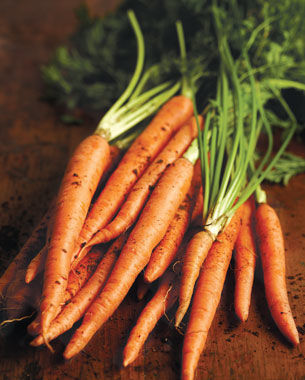
More Favorite Picks:
‘Jersey Giant’ asparagus
Days to maturity: Harvest begins the second year after planting crowns.
Asparagus is a perennial vegetable that can live up to 15 years. The variety ‘Jersey Giant’ is an all-male hybrid with pest resistance/tolerance, Fusarium resistance, rust resistance, and a very good eating quality. It also has the best yields of any variety I’ve grown. Plant certified, disease-free, 1-year-old crowns in the spring three to four weeks before the last spring frost date.
Asparagus prefers a partial shade spot and a soil pH between 6.5 and 6.8 (it does poorly at pH levels below 6.0). Dig trenches 5 inches deep and place the crowns with the roots spread out in the bottom. Fill in the trenches with soil as the spears grow, and be sure to mulch for moisture retention and weed suppression. In the second year, when the first spears emerge in spring, either harvest by bending the spears until they snap or cut with a knife just below the soil surface. The harvest usually does not extend past June 15.
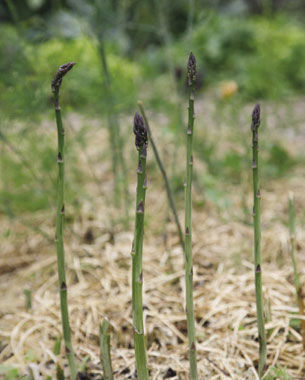
‘Georgia Jet’ sweet potato
Days to maturity: 80 to 90
A red-skinned variety that thrives in our region, ‘Georgia Jet’ tubers have a moist orange flesh that is sweet and excellent for baking. The vines are deep green and have attractive purple-white flowers. Sweet potatoes are grown from slips (the green shoots from a mature sweet potato that are used for planting). Plant the slips in deeply cultivated soil after all danger of frost has passed in late spring to early summer. Nighttime temperatures need to remain above 60°F. Space the slips 10 to 18 inches apart in rows 36 inches apart. Start harvesting at around 80 days and the tubers will continue to grow until harvest. Cure the potatoes in a well-ventilated area for 8 to 10 days for the flesh of ‘Georgia Jet’ to develop a creamy, rich texture.

‘German Extra Hardy’ garlic
Days to maturity: 270
This variety features satin-white bulbs with a strong, spicy flavor. Each ‘German Extra Hardy’ bulb is made up of about six to seven large, red-skinned inner cloves. The flavor is exceptional and the plants have excellent hardiness, despite our harsh winters. Plant the garlic cloves by mid-October to ensure that roots are well established before the cold weather sets in. Garlic yields tend to increase as the size of the mother clove increases.
Therefore, choose the biggest cloves in the bulb for planting. Plant the individual cloves pointed end up 2 inches deep and 5 inches apart. Top-dress the planting area with compost, and then mulch to retain moisture and to prevent frost heaving. Pull back the mulch in spring to allow the soil to warm, then mulch to prevent weeds and conserve moisture. Stiff-neck garlic strains, like ‘German Extra Hardy’, produce flower stems (scapes) that should be removed.
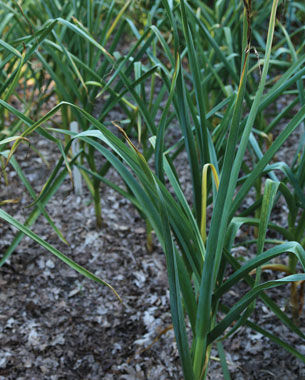
FG’s fun regional fact:
The groundhog Punxsutawney Phil isn’t the only weather watcher to rise to fame in this area. Jim O’Brien became a legend of the Delaware Valley in the 1970s for his wacky on-air forecasts, often referring to weather fronts as “good guys in the North” and “bad humdingers in the South.”
Expert: Elizabeth Alakszay is the master gardener coordinator and an educator for the Pennsylvania State University Agricultural Extension service.
Midwest
Season length: Long
Top Pick:
‘Burpee’s Golden’ beet won’t stain your dishes—or your fingers
Days to maturity: 55
This particular cultivar was popularized by Burpee in the 1970s and represented a color breakthrough. ‘Burpee’s Golden’ beet has a milder and sweeter flavor than traditional red beets, and they don’t turn a meal orange. I try to get beets in the ground as early as possible because their development tends to lag in the hot, humid Midwest summers. Soil temperature should be above 50°F for the best results. I prepare a friable soil bed and then soak the seeds overnight for better germination. The moist seeds are also easier to handle for planting. Make a shallow trench, water it, and then place seeds ½ inch deep and 2 inches apart in the row with a foot between rows. Then cover with soil and firm it down. When the seedlings have several sets of leaves, I thin them to 4 inches apart and use the pulled plants in salads. Keep the beets well watered and weeded, and in less than two months you will have 2-inch-diameter (or more) balls of orange-gold goodness.
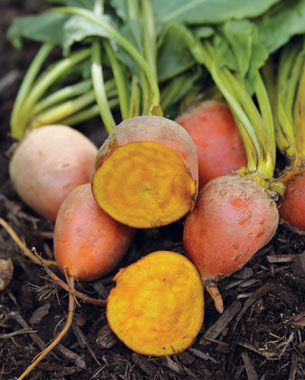
More Favorite Picks:
‘Peaches and Cream’ sweet corn
Days to maturity: 85
‘Peaches and Cream’ is one of the earliest varieties of hybrid bicolor sweet corn. The white and yellow kernels hold their sweetness in the refrigerator, so they can be picked at their peak and kept until you have enough for a platterful. I plant my seeds in a 4-foot by the 4-foot deeply worked garden bed. The seeds are spaced evenly for 16 plants, providing good pollination and ear development. The seeds take a week to germinate in soils near 50°F.
At maturity, the plants will be about 6 feet tall. Ears of corn will be between 6 and 8 inches long and 2 inches in diameter. Resist the urge to peel back the husk and peek at the swelling kernels. You’re just inviting pests to invade. Watch the silks as they dry, and when they turn brown, puncture a few kernels. If the liquid is milky and thick, the ear is ready to pick.
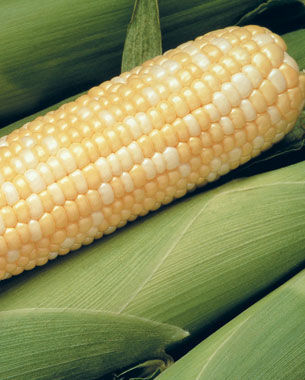
‘Fin de Bagnol’ bush bean
Days to maturity: 55
I discovered this bean during a walk-through tour of the Seed Savers Exchange fulfillment center. The name and the pencil-thin image of the bean intrigued me. Until then, I planted more traditional varieties like ‘Top Crop’ or ‘Provider’. ‘Fin de Bagnol’ bush bean has its origins in France. The ideal soil temperature for planting the seed is above 55°F, but it will germinate—just more slowly—in cooler soils.
I sow the seeds 1 inch deep and 3 inches apart. In central Illinois, the first planting can go in the ground two weeks after the last frost date. ‘Fin de Bagnol’ beans are 4 to 5 inches long and have the best flavor before the half-inch point at the tip of the bean begins to swell. When you pick, be sure to remove the stem from the plant with the bean to encourage continuous bloom. The flavor is crisp and pleasant, as long as you don’t overcook them. My 10-foot row will easily produce 3 pounds of beans by midsummer. In August, I sow the seeds again for a fall crop.
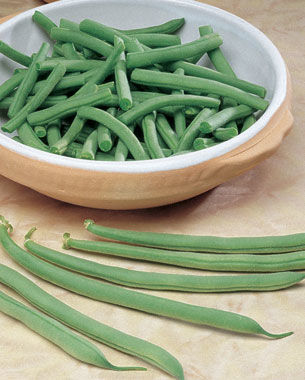
‘Early Jersey Wakefield’ cabbage
Days to maturity: 65
A cabbage with a distinctive shape and mild flavor, ‘Early Jersey Wakefield’ was first grown in Jersey City, New Jersey, in 1840 and remains popular today. I start the seeds indoors, one seed per cell in 50-cell flats, so there’s no need to report before setting out. Seeds are placed ¾ inch deep in germinating mix around the middle of February.
I take a week to harden off the plants before transplanting them to the garden. It is still one of the earliest-maturing cabbages out there. The somewhat conical shape allows for closer spacing of plants. I generally have one plant every 2 feet in a checkerboard pattern. Watch for insect pests, and water frequently after planting. Be sure to monitor the developing plants as they reach maturity. If heavy rain is predicted and the cabbage is close to maturity, harvest it, as too much rain will lead to the head cracking.

FG’s fun regional fact:
The Midwest is often referred to as the Corn Belt, and for good reason. As of 2008, the top four corn-producing states were Iowa, Illinois, Nebraska, and Minnesota, together accounting for more than half of the corn grown in the United States.
Expert: Keith Crotz is a board member for Seed Savers Exchange and grows veggies on a farm that has been in his family for more than 100 years in Chillicothe, Illinois.
Southern Plains
Season length: Short
Top Pick:
‘Giant Caesar’ lettuce proves that bigger is better
Days to maturity: 70
This romaine lettuce is known for its size: The large, deep green leaves can reach 16 inches long and 10 inches wide. ‘Giant Caesar’ combines the taste of romaine and the texture of a butterhead. Like other lettuces, seeds can be direct-sown in early spring and late summer for a fall crop. However, because this variety transplants and separates easily, it is a good choice for starting indoors. Seedlings must be thinned immediately, preferably before the first set of true leaves start to develop. If possible, plant transplants on a cloudy day or in the evening. For the best growth, plants shouldn’t be crowded. Space them at least 8 to 10 inches apart. Protect the plants from heat using shade cloth, and apply mulch to retain moisture. The head of ‘Giant Caesar’ can be harvested whole, or by picking only the outermost leaves and leaving the inner leaves to grow.
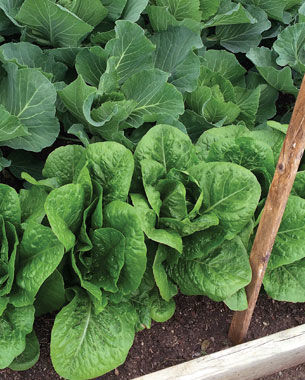
More Favorite Picks:
‘Black Beauty’ squash
Days to maturity: 50
This dark-green-skinned heirloom variety is one of the most popular of its type. ‘Black Beauty’ was an All-America Selections winner in 1957. Seeds should be direct-sown after the danger of frost has passed, in hills 4 feet apart and thinned to two to three plants per hill. For short growing seasons or earlier harvests, start seeds indoors. ‘Black Beauty’ is a bush, semi-upright variety that is easy to grow and very productive. Use row covers to protect plants from pests, and mulch to retain moisture and suppress weeds.
The squash ripens during the hot summer months, and once the plants start to produce, they will continue through the growing season. Fruits can be picked at any point but are best harvested at 6 to 8 inches long, when they are still young and tender. ‘Black Beauty’ squash is excellent steamed, baked, sautéed, fried, frozen, or simply eaten raw. In addition, its blossoms are edible and can be used in a variety of recipes.
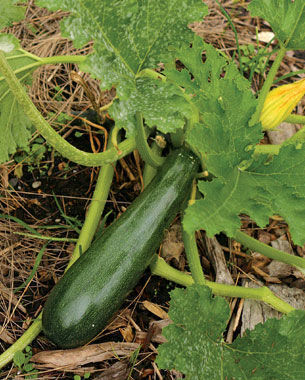
‘Juliet’ tomato
Days to maturity: 60
This 1999 All-America Selections Winner is related to but slightly larger than ‘Santa’ grape tomato. ‘Juliet’ is a popular indeterminate variety that’s shaped like a plum or grape type but is categorized as cherry-type. Long and vigorous vines produce several clusters of 12 to 18 fruits, weighing around an ounce.
As with other tomatoes, the seeds should be started indoors, about 6 to 8 weeks before the last average frost. Use mulch to cut down on splashing soils and the transfer of potential disease onto the foliage. This variety has better crack resistance than most cherry tomatoes and can hold on to the vine longer, too. ‘Juliet’ is sweet, bite-sized, and perfect for salads; it is also meaty, which makes it great for salsa and sauces. The plants are tolerant of late blight and resistant to early blight.
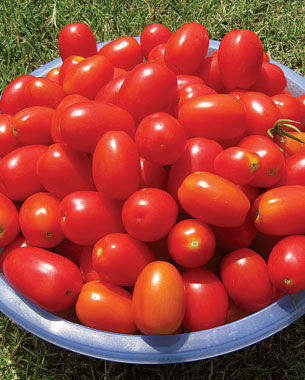
‘Blue Lake 274’ bush green bean
Days to maturity: 60
‘Blue Lake 274’ was developed in 1961 from the popular ‘Pole Blue Lake’ bean and is an all-time favorite of mine. The seeds are best direct-sown after all danger of frost is past in spring and the soil has warmed. Sow seeds 1 inch apart, then thin to 2 to 3 inches apart. The dark-green pods are 5 to 6 inches long with white seeds. Once the plants get established, they grow quickly. At full size, the plants are 12 to 16 inches tall.
Although the plants don’t require support, containing them with a wire mesh “wall” may be necessary for a raised bed and in windy locations. The plants have beautiful white and lavender flowers, which, when they fall off, reveal the tiny growing beans. The pods are plump, tender, nearly fiber-free, and have excellent flavor. ‘Blue Lake 274’ matures in a short period of time (two to three weeks). The plants are virus and pest-resistant, as well as heat and humidity-tolerant.
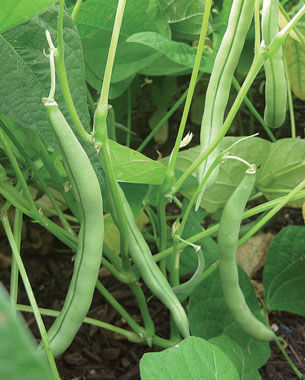
FG’s fun regional fact:
The hottest day ever in Texas (120°F) was June 28, 1994, recorded in Monahans, a town roughly 250 miles east of El Paso.
Expert: Greg Holdsworth is the owner of Your Own Victory Garden, an organic vegetable gardening and consultant firm in Plano, Texas.
Northwest
Season length: Short
Top Pick:
‘Windsor’ fava bean germinates in cool soils
Days to maturity: 80 (spring-sown); 240 (fall sown)
Winter gardening is one of the pluses of living in our cool maritime climate, and fava beans are my favorite overwintering crop. Because fava beans can germinate in cool soil, around here you can plant seeds all the way through October. With fall-sown beans, you can expect a harvest by June, but you can also plant seeds in spring and get a harvest by the end of summer. The variety ‘Windsor’ is known for its large, broad beans that, when mature, are the size of your thumb. Mature beans are best shucked from their pods and then shelled out of their thick skins, but tender young pods can be cooked and eaten just like regular green beans. Don’t forget to save a few seeds to plant next year.
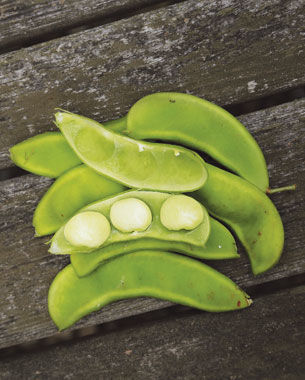
More Favorite Picks:
‘Ozette’ potato
Days to maturity: 100
This unusual potato has the distinction of being the only variety that came to us directly from South America rather than being brought from Europe like other potatoes. It was introduced by Spanish explorers to Neah Bay on the Olympic Peninsula in the 1700s and has been grown as a staple food crop by the people of the Makah nation for over 200 years.
‘Ozette’ is an attractive fingerling with flesh that is firm, creamy, and considered tops in flavor. Because of its history, it is well suited for our climate and very easy to grow even in the cool, rainy Pacific Northwest. Once hard to find and even placed in the Slow Food Ark of Taste, seed potatoes of ‘Ozette’ are now easier to get your hands on and well worth planting in your garden.
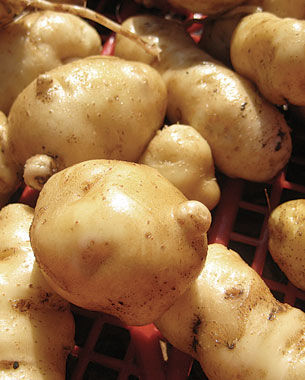
‘Stupice’ tomato
Days to maturity: 65
‘Stupice’ was bred in former Czechoslovakia, a place with cooler, shorter summers. This indeterminate, potato-leaf variety ripens tasty tomatoes early and continues to fruit throughout summer. A smaller, salad-type tomato, the 2- to 3-inch fruits are prolific and the plants do well even in container gardens. Many gardeners choose ‘Stupice’ as their go-to because it consistently produces no matter the circumstances. Start the seeds indoors in March, then harden off and transplant outside when nighttime temperatures stay above 50°F.
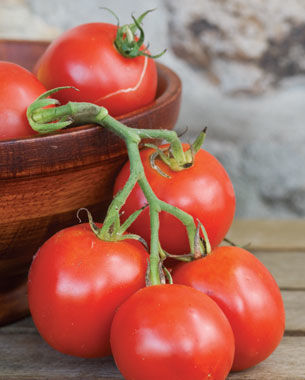
‘Fordhook Giant’ Swiss chard
Days to maturity: 60
Though the brightly colored Swiss chards tend to be more popular due to their looks, this unassuming white-stemmed variety will soon become your favorite. A sure thing even in cool summers, marginal soil, and limited sun, ‘Fordhook Giant’ Swiss chard comes on strong and shoots up like gangbusters.
Growing up to 2 feet high with juicy stems and large, succulent leaves, each plant yields more food than you’d expect, and the harvest keeps coming. Its flavor is similar to spinach (but it won’t bolt in summer), so I use it as a substitute for all my dishes featuring spinach—from saag paneer to spanakopita.
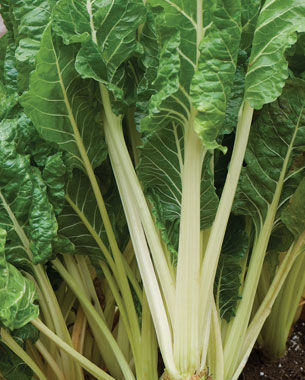
FG’s fun regional fact:
Seattle ranks 44th among major U.S. cities in average annual rainfall, getting approximately 38 inches annually. Cities that get more rainfall than Seattle include Houston, Texas (48 inches); Mobile, Alabama (65 inches); and almost every major city on the eastern seaboard, such as New York (43 inches).
Expert: Carey Thornton is a garden educator at Seattle Tilth, teaching thousands of people each year how to grow food using organic methods.
California
Season length: Long
Top Pick:
‘Goldmine’ zucchini has a distinctive, nutty flavor
Days to maturity: 50
More unique than a green zucchini and more refined than a yellow crookneck, ‘Goldmine’ is a handsome summer squash with sunshine yellow skin that’s fringed with white stripes. It has the nutty flavor and creamy texture you’d expect from a zucchini. It’s best to pick them when they’re about 2 inches long with the flower still attached, though they taste great up to about 5 to 6 inches long. Plant them at the front of a raised bed, and let the plant flop over the face of the bed both to conserve space and for dramatic effect. ‘Goldmine’ zucchini, like most squash plants, is susceptible to powdery mildew, but I’ve had good success controlling it with potassium bicarbonate. It’s common to see squash leaves droop in the midday sun, even when they have enough water, but as long as they’re perked up in the morning, your plants should be fine.
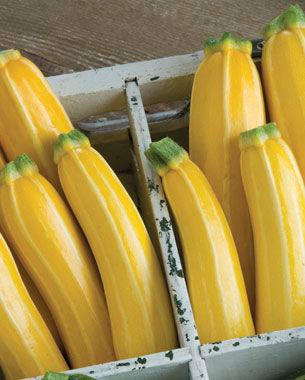
More Favorite Picks:
‘Rattlesnake’ pole bean
Days to maturity: 60 (fresh); 90 (dried)
I was introduced to this exceptional pole bean by Territorial Seed Company and initially grew it for its electric purple striping. After growing the variety for a full season, though, I was hooked not only on the beans’ beauty but also their vigor and flavor.
We grow our beans on trellises or pole tepees from April to August. Direct-sow two to three of the bespeckled seeds per pole with bean inoculant, which promotes root development. Typically, you don’t have to thin pole beans, but I like to top errant vines or train them back down the tepee. For a high yield, tender textures, and the best flavor, harvest the fresh beans before you can see the bumps of the seeds forming. Alternatively, let the beans fully form on the vine for drying and storing.
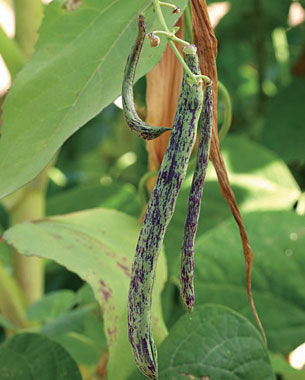
‘Calliope’ eggplant
Days to maturity: 65
In Greek mythology, Calliope is the muse with the most beautiful voice, and similarly, it’s easy to sing the praises of this exceptional eggplant. With a spineless calyx and striking purple and white striping, this variety is as ornamental as it is delicious. These smaller Asian-style fruits are best when picked around 2 inches long, and once the harvest begins, these abundant aubergines can continue to produce into early fall. When the temperatures start to rise in July, watch out for spider mites and flea beetles, which can be tough to manage organically.
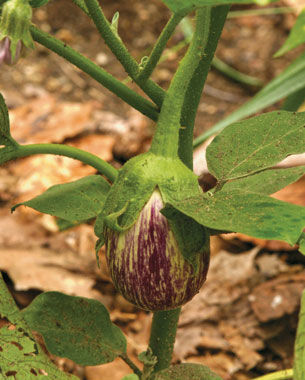
‘Carmello’ tomato
Days to maturity: 70 to 75
Along with the ever-popular ‘Sungold’, the globe-shaped ‘Carmello’ will redefine everything you think you know about hybrid tomatoes. This esteemed French market variety has the early harvest, abundant production, and disease hardiness that one would expect from a hybrid but with excellent sweet, floral tomato flavor far exceeding similar slicing types.
With such a long growing season, we stick with indeterminate, or vining, tomato varieties like ‘Carmello’ for their ongoing yield late into the season. Summer temperatures climb over 90°F for days at a time in our climate, but we stave off blossom drop, sunscald, and other heat stress with floating row covers or shade cloths.
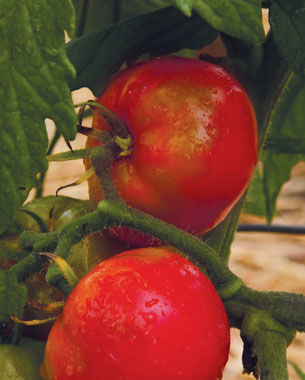
FG’s fun regional fact:
California has too many agricultural festivals to count, but one in particular pulls in thousands of visitors from around the world annually. Every October, the town of Carpinteria plays host to the California Avocado Festival—home to the world’s largest vat of guacamole.
Expert: Matthew Geldin is the head farmer for Farmscape, the largest urban farming organization in California.
Are you a short-season or a long-season grower?
Most gardeners know in what zone they live. That’s likely because folks want to be sure they’re investing in plants that will reliably come back each year. What many gardeners don’t know, however, is whether they live in a short-season or long-season section of the country. All veggies need a number of perfect growing days (not too hot, nor too cold) in order to mature. If you select a tomato that takes 120 days to set and ripen its fruit but live in northern Maine, chances are you will never harvest a single tomato off that plant.
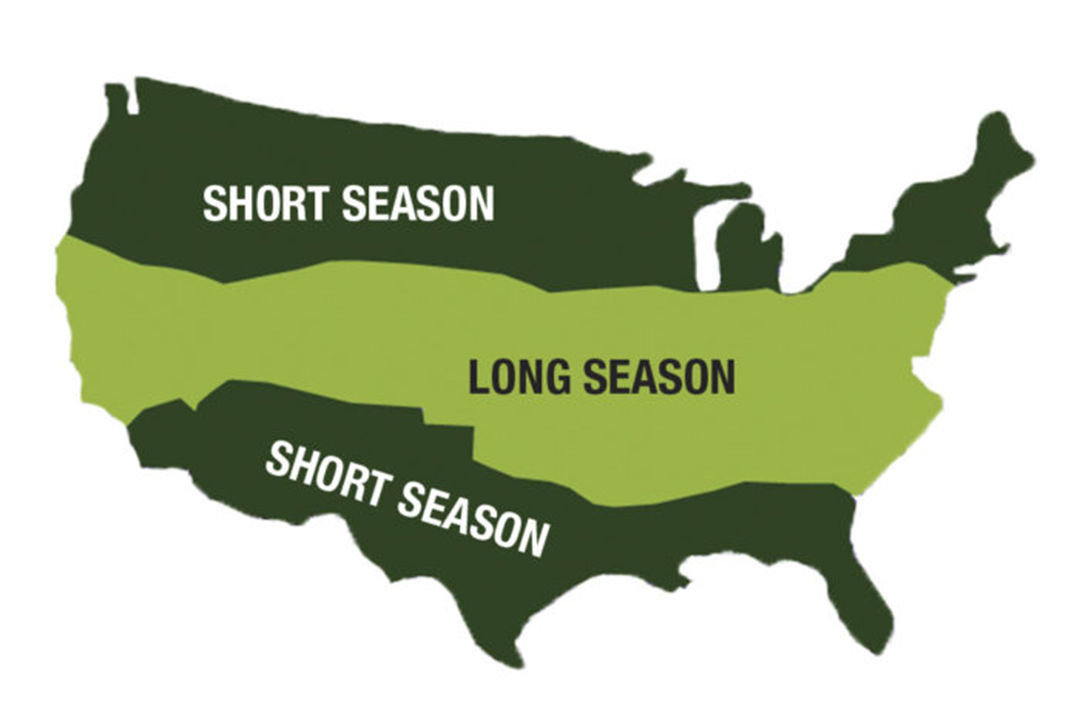
• Short-season growers should look for veggies that take 80 days to maturity or less.
• Long-season growers can grow veggies that take more than 80 days to mature.
Photos, except where noted: courtesy of Southern Exposure Seed Exchange
Drawings: staff
Sources
- W. Atlee Burpee & Co., Warminster, PA; 800-888-1447; burpee.com
- Baker Creek Heirloom Seed Co., Mansfield, MO; 417-924-8917; rareseeds.com
- Botanical Interests, Broomfield, CO; 877-821-4340; botanicalinterests.com
- Harris Seeds, Rochester, NY; 800-544-7938; harrisseeds.com
- Johnny’s Selected Seeds, Winslow, ME; 877-564-6697; johnnyseeds.com
- Southern Exposure Seed Exchange, Mineral, VA; 540-894-9480; southernexposure.com




















Comments
Log in or create an account to post a comment.
Sign up Log in